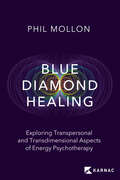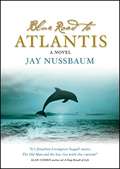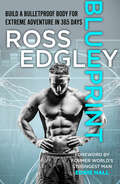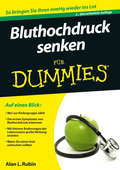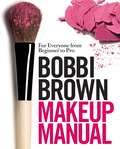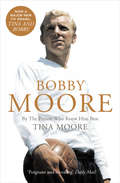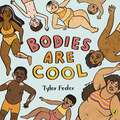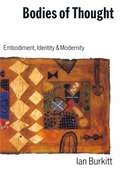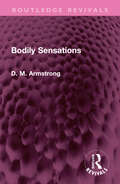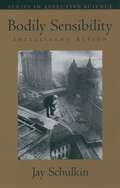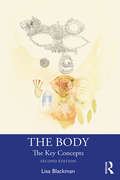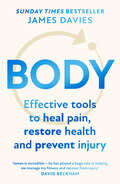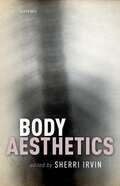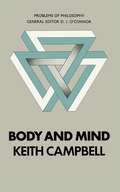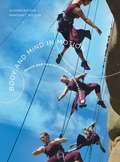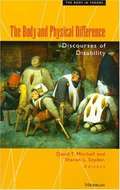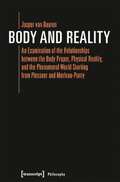- Table View
- List View
Blue Diamond Healing: Exploring Transpersonal and Transdimensional Aspects of Energy Psychotherapy
by Phil Mollon“For decades, Phil Mollon has been one of the most thoughtful and well-grounded voices within the field of energy psychology. So when Dr. Mollon says he is dabbling with powerful healing forces you’ve never heard of, it’s worth a listen. And this book is so much more than just a listen, laying out a new take on the higher dimensions of human experience, integrating it with established psychological principles, and pointing to its implications for your life and practice.” David Feinstein, Ph.D. co-author of The Promise of Energy Psychology Blue Diamond healing, a development from energy psychotherapy, is the result of Phil Mollon’s many years spent exploring the deeper patterns in the human subtle energy system, working beyond the more familiar meridians and chakras. The ‘Blue Diamond’ functions as an energy centre allowing access to higher dimensions that therapists can draw upon to heal the problematic patterns at lower dimensions. Positive effects are achieved more quickly and easily by working from these higher levels, facilitating healing, emotional self-regulation and calming of the nervous system. In Blue Diamond Healing, Mollon provides a hypothetical map of dimensional levels and structures, combining psychology, physics, metaphysics, cosmology, and spirituality, all in one far-reaching framework. The book provides a sophisticated but concise outline of energy psychotherapy and the place of the Blue Diamond within it, including sections on best practice and the ethical aspects of this unique and powerful healing method.
The Blue Road To Atlantis
by Jay NussbaumIn the tradition of The Celestine Prophecy and Jonathan Livingston Seagull, THE BLUE ROAD TO ATLANTIS is an inspirational retelling of Hemingway's The Old Man and the Sea. This is a gently humorous and ultimately touching story told from the perspective of a remora who is travelling with his mentor, a wise and beautiful marlin, to Atlantis in order to save the lives of all the fish in the ocean. En route to Atlantis, the marlin is hooked by a fisherman, who turns out to be Hemingway's character from The Old Man and the Sea. As the marlin struggles for survival, he ponders the meaning of life, the importance of love, friendship and forgiveness, the power of fear and the importance of following one's dreams at all costs. His thoughts encourage readers to 'go with the current' by accepting the ebb and flow of life and not fighting against our instinct and our intuition, but rather following the current of our heart and soul to happiness and contentment.
Blueprint: Build A Bulletproof Body For Extreme Adventure In 365 Days
by Ross EdgleyFrom world-renowned adventurer and bestselling author of The Art of Resilience and The World’s Fittest Book, comes the ultimate blueprint to (re)building a bulletproof body. ‘He’s an animal’ CHRIS HEMSWORTH ‘The inner workings of a sports science genius’ EDDIE HALL, former World’s Strongest Man
Bluey: Hammerbarn (Bluey)
by BlueyBluey and her family are shopping at Hammerbarn for a pizza oven. Bluey and Bingo play neighbours in their trolleys with mini-homes and yards.Will neighbours Bluey and Bingo get along?What other adventures will you go on with Bluey? Also available:Bluey: TypewriterBluey: The CreekBluey: ShadowlandsBluey: Swim School
Bluthochdruck senken für Dummies (Für Dummies)
by Alan L. RubinWerden Sie aktiv und lassen Sie dem Bluthochdruck keine Chance Wir alle wissen es: Zu fettes Essen, Stress, zu wenig Bewegung, zu wenig Schlaf, ein oder zwei Gläschen Wein oder Bier – gesund ist das nicht. Viel schlimmer noch: So wird man zum klassischen Bluthochdruck-Kandidaten. Eine tückische Krankheit, denn erst einmal tut nichts weh, aber die gesundheitlichen Risiken sind groß: Schlaganfall und Herzinfarkt. Der Arzt Alan L. Rubin schildert leicht verständlich und ohne erhobenen Zeigefinger, welche Signale der Körper gibt, wie man Bluthochdruck vorbeugen und mit welchen Therapien man dieser Volkskrankheit erfolgreich begegnen kann.
Boat-neck and crew-neck tops (large print)
by RnibThere are two images of women's clothing on this page: a boat-neck top on the left and a crew-neck top on the right. Both tops are seen from the front with their neck openings at the top of the images and hems at the bottom. The sleeves are to each side. There is a locator dot shown, which will be at the top left of the page when the image is the correct way up. The boat-neck top has a wide neck opening that reaches almost to the shoulders on either side but only comes down the chest a short distance. It is tightly fitted and has long sleeves in this example. The crew-neck top has a small rounded neck opening and is tightly fitted with short sleeves.
Boat-neck and crew-neck tops (UEB contracted)
by RnibThere are two images of women's clothing on this page: a boat-neck top on the left and a crew-neck top on the right. Both tops are seen from the front with their neck openings at the top of the images and hems at the bottom. The sleeves are to each side. There is a locator dot shown, which will be at the top left of the page when the image is the correct way up. The boat-neck top has a wide neck opening that reaches almost to the shoulders on either side but only comes down the chest a short distance. It is tightly fitted and has long sleeves in this example. The crew-neck top has a small rounded neck opening and is tightly fitted with short sleeves.
Boat-neck and crew-neck tops (UEB uncontracted)
by RnibThere are two images of women's clothing on this page: a boat-neck top on the left and a crew-neck top on the right. Both tops are seen from the front with their neck openings at the top of the images and hems at the bottom. The sleeves are to each side. There is a locator dot shown, which will be at the top left of the page when the image is the correct way up. The boat-neck top has a wide neck opening that reaches almost to the shoulders on either side but only comes down the chest a short distance. It is tightly fitted and has long sleeves in this example. The crew-neck top has a small rounded neck opening and is tightly fitted with short sleeves.
Bobbi Brown Makeup Manual: For Everyone from Beginner to Pro
by Bobbi BrownThis is the book that makeup fans have been waiting for - Bobbi Brown's twenty-five-plus years of makeup styling experience distilled into one complete, gorgeous book. Bobbi looks at everything from skincare basics to every aspect of facial makeup - from how to find the right colour and type of foundation for any skin tone to how to apply every detail of eye makeup (brows, eyeliner, eye shadow and eyelashes) no matter the eye colour and shape. Of course there are never-before-seen tips on blush, bronzer, lip liners, lipstick and more. And Bobbi looks beyond the face with informative chapters on head-to-toe beauty and the science of skin.
Bobby Moore (Text Only): By The Person Who Knew Him Best
by Tina MooreTHE STORY WHICH INSPIRED THE MAJOR ITV DRAMA TINA AND BOBBY.
Bodies Are Cool: A picture book celebration of all kinds of bodies
by Tyler FederThis body positive picture book is a vibrant, joyful, and judgement-free celebration of every body shape and size.My body, your body, every different kind of body!All of them are good bodies! BODIES ARE COOL!This heart-warming, inclusive book, filled with detailed and friendly illustration is a celebration of every kind of body that exists in the world. Through an empowering, rhythmic text that is perfect for reading aloud, little ones can explore various skin tones, body shapes, hair types, and more, in an accessible way that instills body positivity and confidence.The picture book debut from talented author/illustrator Tyler Feder, whose inclusive artwork - full of warmth and humour - has earned her a large social media following through her brand, Roaring Softly.
Bodies of Thought
by Ian BurkittIn this incisive and truly impressive book, Ian Burkitt critically addresses the dualism between mind and body, thought and emotion, rationality and irrationality, and the mental and the material, which haunt the post-Cartesian world. Drawing on the work of contemporary social theorists and feminist writers, he argues that thought and the sense of being a person is inseparable from bodily practices within social relations, even though such active experience may be abstracted and expanded upon through the use of symbols. Overcoming classic dualisms in social thought, Burkitt argues that bodies are not purely the constructs of discourses of power: they are also productive, communicative, and invested with powerful capacities for changing the social and natural worlds. He goes on to consider how such powers can be developed in more ethical forms of relations and activities.
Bodily Sensations (Routledge Revivals)
by D M ArmstrongFirst published in 1962, Bodily Sensations argues that bodily sensations are nothing but impressions that physical happenings are taking place in the body, impressions that may correspond or fail to correspond to physical reality. In the case of such sensations as pains, these impressions are accompanied by certain attitudes to the impressions. He argues, that is to say that bodily sensations are a sub-species of sense-impression, standing to perception of our own bodily state (or in some cases to touch) as visual impressions stand to the sense of sight. He examines, and tries to refute, all plausible alternative accounts of the nature of bodily sensations. He prefaces his argument by an account of tactual and bodily perception. Here he argues that, with the exception of heat and cold, the qualities discerned by these senses are all reducible to spatial and temporal properties of material objects. Combined with his own conclusions on bodily sensations, this allows him to draw up a short and exhaustive list of the so-called "secondary" qualities of physical objects. This book will be of interest to students of philosophy.
Bodily Sensations (Routledge Revivals)
by D M ArmstrongFirst published in 1962, Bodily Sensations argues that bodily sensations are nothing but impressions that physical happenings are taking place in the body, impressions that may correspond or fail to correspond to physical reality. In the case of such sensations as pains, these impressions are accompanied by certain attitudes to the impressions. He argues, that is to say that bodily sensations are a sub-species of sense-impression, standing to perception of our own bodily state (or in some cases to touch) as visual impressions stand to the sense of sight. He examines, and tries to refute, all plausible alternative accounts of the nature of bodily sensations. He prefaces his argument by an account of tactual and bodily perception. Here he argues that, with the exception of heat and cold, the qualities discerned by these senses are all reducible to spatial and temporal properties of material objects. Combined with his own conclusions on bodily sensations, this allows him to draw up a short and exhaustive list of the so-called "secondary" qualities of physical objects. This book will be of interest to students of philosophy.
Bodily Sensibility: Intelligent Action (Series in Affective Science)
by Jay SchulkinAlthough we usually identify our abilities to reason, to adapt to situations, and to solve problems with the mind, recent research has shown that we should not, in fact, detach these abilities from the body. This work provides an integrative framework for understanding how these abilities are affected by visceral reactions. Schulkin presents provocative neuroscientific research demonstrating that thought is not on one side and bodily sensibility on the other; from a biological point of view, they are integrated. Schulkin further argues that this integration has important implications for judgements about art and music, moral sensibilities, attraction and revulsion, and our perpetual inclination to explain ourselves and our surroundings.
The Body: The Key Concepts
by Lisa BlackmanThoroughly updated and revised throughout with brand new chapters on affective bodies, indeterminate bodies, assemblaged bodies and a new conclusion, and featuring essay and classroom questions for classroom use, The Body: Key Concepts, Second Edition, presents a concise and up-to-date introduction to, and analysis of, the complex and influential debates around the body in contemporary culture. Lisa Blackman outlines and illuminates those debates which have made the body central to current interdisciplinary thinking across the arts, humanities and sciences. Since body studies hit the mainstream, it has grown in new regions, including China, and moved in new directions to question what counts as a body and what it means to have and be a body in different contexts, milieu and settings. Lisa Blackman guides the reader through socio-cultural questions around representation, performance, class, race, gender, disability and sexuality to examine how current thinking about the body has developed and been transformed. Blackman engages with classic anthropological scholarship from Nancy Scheper-Hughes and Margaret Lock, revisits black feminist writings from the 1980s, as well as engaging with recent debates, thought and theorists who are inventing new concepts, methods and ways of apprehending embodiment which challenge binary and dualistic categories. It provides an overview of the proliferation of body studies into other disciplines, including media and cultural studies, philosophy, gender studies and anthropology, as well as mapping the future of body studies at the intersections of body and affect studies.
The Body: The Key Concepts
by Lisa BlackmanThoroughly updated and revised throughout with brand new chapters on affective bodies, indeterminate bodies, assemblaged bodies and a new conclusion, and featuring essay and classroom questions for classroom use, The Body: Key Concepts, Second Edition, presents a concise and up-to-date introduction to, and analysis of, the complex and influential debates around the body in contemporary culture. Lisa Blackman outlines and illuminates those debates which have made the body central to current interdisciplinary thinking across the arts, humanities and sciences. Since body studies hit the mainstream, it has grown in new regions, including China, and moved in new directions to question what counts as a body and what it means to have and be a body in different contexts, milieu and settings. Lisa Blackman guides the reader through socio-cultural questions around representation, performance, class, race, gender, disability and sexuality to examine how current thinking about the body has developed and been transformed. Blackman engages with classic anthropological scholarship from Nancy Scheper-Hughes and Margaret Lock, revisits black feminist writings from the 1980s, as well as engaging with recent debates, thought and theorists who are inventing new concepts, methods and ways of apprehending embodiment which challenge binary and dualistic categories. It provides an overview of the proliferation of body studies into other disciplines, including media and cultural studies, philosophy, gender studies and anthropology, as well as mapping the future of body studies at the intersections of body and affect studies.
Body
by null James DaviesThe Sunday Times bestseller with all the strategies you need to prevent pain and fuel your body to its fullest health potential. ‘James is incredible – he has played a huge role in helping me manage my fitness and recover from injury over the years’ David Beckham Simple techniques and strategies to HEAL From stress and anxiety, to everyday wear and tear and injury, life takes its toll on our bodies. Now, internationally renowned osteopath James Davies can help you heal your body. RESET With tips and tricks to help recognise, manage, and treat everyday aches and pains, this book will reset your approach to understanding your body. James presents a revolutionary blueprint for holistic body wellbeing. RESTORE Improve your wellbeing with exercises expertly designed to optimise your body. Enhance your health and mobility by understanding common conditions from arthritis and muscle strains, to IBS and stress, and empower yourself with the knowledge you need to achieve full-body health. BODY was number 9 in the Sunday Times Bestseller Chart w/b 12th September 2022
Body Aesthetics
by Sherri IrvinThe body is a rich object for aesthetic inquiry. We aesthetically assess both our own bodies and those of others, and our felt bodily experiences-as we eat, have sex, and engage in other everyday activities-have aesthetic qualities. The body, whether depicted or actively performing, features centrally in aesthetic experiences of visual art, theatre, dance and sports. Body aesthetics can be a source of delight for both the subject and the object of the gaze. But aesthetic consideration of bodies also raises acute ethical questions: the body is deeply intertwined with one's identity and sense of self, and aesthetic assessment of bodies can perpetuate oppression based on race, gender identity, sexual orientation, age, size, and disability. Artistic and media representations shape how we see and engage with bodies, with consequences both personal and political. This volume contains sixteen original essays by contributors in philosophy, sociology, dance, disability theory, critical race studies, feminist theory, medicine, and law. Contributors take on bodily beauty, sexual attractiveness, the role of images in power relations, the distinct aesthetics of disabled bodies, the construction of national identity, the creation of compassion through bodily presence, the role of bodily style in moral comportment, and the somatic aesthetics of racialized police violence.
Body Aesthetics (PDF)
by Sherri IrvinThe body is a rich object for aesthetic inquiry. We aesthetically assess both our own bodies and those of others, and our felt bodily experiences-as we eat, have sex, and engage in other everyday activities-have aesthetic qualities. The body, whether depicted or actively performing, features centrally in aesthetic experiences of visual art, theatre, dance and sports. Body aesthetics can be a source of delight for both the subject and the object of the gaze. But aesthetic consideration of bodies also raises acute ethical questions: the body is deeply intertwined with one's identity and sense of self, and aesthetic assessment of bodies can perpetuate oppression based on race, gender identity, sexual orientation, age, size, and disability. Artistic and media representations shape how we see and engage with bodies, with consequences both personal and political. This volume contains sixteen original essays by contributors in philosophy, sociology, dance, disability theory, critical race studies, feminist theory, medicine, and law. Contributors take on bodily beauty, sexual attractiveness, the role of images in power relations, the distinct aesthetics of disabled bodies, the construction of national identity, the creation of compassion through bodily presence, the role of bodily style in moral comportment, and the somatic aesthetics of racialized police violence.
Body and Mind in Motion: Dance and Neuroscience in Conversation (PDF)
by Glenna Batson Margaret WilsonDrawing from the burgeoning field of 'embodiment' – itself an idea at the intersection of the sciences, humanities, arts and technologies – Body and Mind in Motion highlights the relevance of somatic education within dance education, dance science and body-mind studies.
The Body And Physical Difference: Discourses Of Disability
by David T. Mitchell Sharon L. SnyderFor years the subject of human disability has engaged those in the biological, social and cognitive sciences, while at the same time, it has been curiously neglected within the humanities. The Body and Physical Difference seeks to introduce the field of disability studies into the humanities by exploring the fantasies and fictions that have crystallized around conceptions of physical and cognitive difference. Based on the premise that the significance of disabilities in culture and the arts has been culturally vexed as well as historically erased, the collection probes our society's pathological investment in human variability and "aberrancy. " The contributors demonstrate how definitions of disability underpin fundamental concepts such as normalcy, health, bodily integrity, individuality, citizenship, and morality--all terms that define the very essence of what it means to be human. The book provides a provocative range of topics and perspectives: the absence of physical "otherness" in Ancient Greece, the depiction of the female invalid in Victorian literature, the production of tragic innocence in British and American telethons, the reconstruction of Civil War amputees, and disability as the aesthetic basis for definitions of expendable life within the modern eugenics movement. With this new, secure anchoring in the humanities, disability studies now emerges as a significant strain in contemporary theories of identity and social marginality. Moving beyond the oversimplication that disabled people are marginalized and made invisible by able-ist assumptions and practices, the contributors demonstrate that representation is founded upon the perpetual exhibition of human anomalies. In this sense, all art can be said to migrate toward the "freakish" and the "grotesque. " Such a project paradoxically makes disability the exception and the rule of the desire to represent that which has been traditionally out-of-bounds in polite discourse. The Body and Physical Difference has relevance across a wide range of academic specialties such as cultural studies, the sociology of medicine, history, literature and medicine, the allied health professions, rehabilitation, aesthetics, philosophical discourses of the body, literary and film studies, and narrative theory. David T. Mitchell is Assistant Professor of English, Northern Michigan University. Sharon L. Snyder teaches film and literature at Northern Michigan University.
Body and Practice in Kant (Studies in German Idealism #6)
by Helge SvareKant is generally conceived to have offered little attention to the fact that we experience the world in and through our bodies. This book argues that this standard image of the great German philosopher is radically wrong. Not only does Kant - throughout his career and in works published before and after the Critique of pure reason - reflect constantly upon the fact that human life is embodied, but the Critique of pure reason itself may be read as a critical reflection aimed at exploring some significant philosophical implications of this fact. Bringing this aspect of Kant's philosophy into focus is important, not only because it sheds new light on our understanding of Kant's work, but also because it is relevant to contemporary discussions in philosophy about embodiment, learning and practice. By taking his philosophy of embodiment into account, the author makes Kant stand out as a true contemporary in new and unexpected ways.
Body and Reality: An Examination of the Relationships between the Body Proper, Physical Reality, and the Phenomenal World Starting from Plessner and Merleau-Ponty (Edition Moderne Postmoderne)
by Jasper van BuurenIs materialism right to claim that the world of everyday-life experience - the phenomenal world - is nothing but an illusion produced in physical reality, notably in the brain? Or is Merleau-Ponty right when he defends the fundamental character of the phenomenal world while rejecting physical realism? Jasper van Buuren addresses these questions by exploring the nature of the body proper in Merleau-Ponty and Plessner, arguing that physical and phenomenal realism are not mutually exclusive but complementary. The argument includes a close examination of the relationships between scientific and pre-scientific perspectives, between living and non-living things, and between humans and animals.
